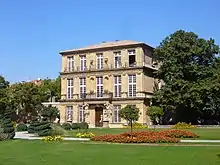Pavillon Vendôme
The Pavillon Vendôme is a historic pavilion surrounded by a French formal garden located 32 rue Celony in Aix-en-Provence, France.



History
It was built by architect Pierre Pavillon (1612-1670) between 1665 and 1667.[1][2][3][4][5]
It was commissioned by for Louis, Duke of Vendôme (1612-1669) as a place where he could take his lover, Lucrèce de Forbin Solliès, also known as "la Belle du Canet".[1][3][4][6] He died in the house on 6 August 1669.[6]
Later, it was owned by the painter Jean-Baptiste van Loo (1684-1745), who had a studio there.[7] It was subsequently purchased by Barthélemy-Louis Reboul, Secretary of the Académie des Sciences, Agriculture, Arts et Belles Lettres d'Aix.[7]
After the French Revolution of 1789, it was purchased by Jean-Joseph-Pierre Guigou, who was Bishop of Angoulême, who turned it into a Catholic boarding school for girls.[7]
In 1906, it was purchased by Henri Dobler (1863-1941), a Swiss art collector, painter and poet.[1][4] He donated it to the city of Aix-en-Provence after his death.[1] It has served as a museum since then.[1] It is home to temporary art exhibitions.[1][2]
Heritage significance
The house has been listed as a Monument historique since 27 March 1914; the garden since 15 October 1953.[8]
References
- Tourism Office
- Aix en provence, pays Aixois et Salonais, Le Petit Futé, 2010, p. 150
- Dominique Auzias, Jean-Paul Labourdette, Le Petit Futé, 2011, p. 191
- Le Pavillon Vendôme rend justice à Henri Dobler, La Provence, September 02, 2012
- Aix-en-Provence Tourism: Pierre Pavillon
- Ambroise Roux-Alphéran, Les Rues d'Aix, 1846
- Maurice Pezet, La Provence et l'amour, éd. F. Sorlot/F. Lanore, Paris, 1984, p. 121
- Notice no. PA00081103, Base Mérimée, French Ministry of Culture